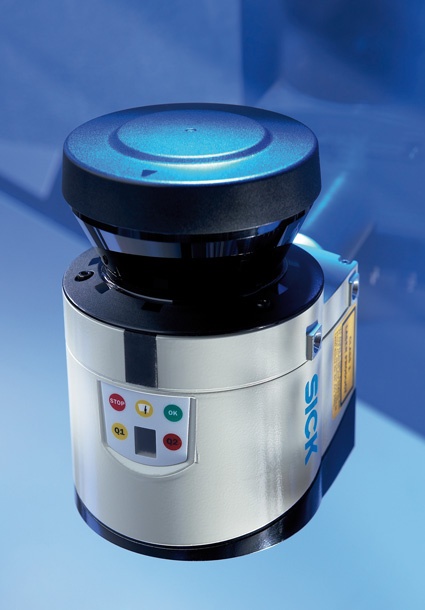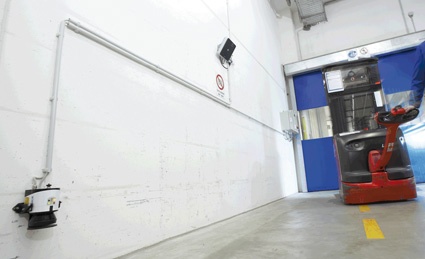Logistic Acces Control: Secure Movement of Goods in the USA
According to the U.S. Customs Authority, the best way to protect against terrorism when importing goods into the United States is a secure, end-to-end supply chain. Those involved ...


According to the U.S. Customs Authority, the best way to protect against terrorism when importing goods into the United States is a secure, end-to-end supply chain. Those involved in the supply chain are required to implement a number of organizational and technical measures in accordance with the Customs-Trade Partnership Against Terrorism. SICK‘s Logistic Access Control (LAC) is an access control system that ensures that goods are handled securely and only by those who are authorized to do so.
LAC offers a complete, ready-to-use solution involving laser measurement technology, radio frequency identification (RFID), and sensor integrated software. It was developed in line with the objectives of the Customs-Trade Partnership Against Terrorism (C-TPAT) and the requirements for obtaining European "Authorized Economic Operator" (AEO) status. The sensor is capable of detecting persons and vehicles in motion, while maintaining the flow of traffic, identifying them with the help of coded transponder cards. Any unauthorized persons or items are reliably detected and prevented from accessing other areas. With the help of intelligent filtering algorithms and plausibility functions, the LAC also provides maximum protection against tampering.
Secure and Safe Movement of Goods throughout the Entire Supply Chain
For over 10 years since the attacks on September 11 2001, international organizations have been working to protect international trade against terrorist attacks. As a result, a variety of proposals have been developed to implement methods for those involved in the movement of goods to ensure a secure supply chain from consignor to aircraft loading. In June 2005, the World Customs Organization (WCO) launched a global SAFE framework in the wake of similar proposals, such as the European "Authorized Economic Operator" certification. AEO certification, i.e. the "Customs Simplifications/Security and Safety Certificate (AEO F), has been available since 2008 and the scheme aims to provide end-to-end security for goods handling throughout the whole supply chain. At the same time, it offers those who hold certification the opportunity to pass through US customs formalities for goods imports quicker and easier than normal.
The Customs-Trade Partnership Against Terrorism - a security partnership between the U.S. Customs Authority and the U.S. economy to combat international terrorism - also operates this type of "incentive" system. All those involved in the supply chain, i.e. importers, carriers, producers or agents, can participate and be recognized as a "known shipper" by C-TPAT. Recipients benefit from faster customs clearance by being allocated an individual duty officer, a lower risk ratio with fewer random checks, and access to the deferred payment system for customs duties. The bottom line is that certification holders have a significant competitive advantage over companies that do not participate in C-TPAT. C-TPAT and AEO require organizational and technical measures to be taken.
The C-TPAT and AEO requirements are valid until end of march 2013, so those involved in goods handling still have time to become certified as a "known shipper" by C-TPAT or an "Authorized Economic Operator" by AEO authorities and immediately gain the benefits. Companies involved in the various stages of the product supply chain are encouraged, as laid out in the relevant guidelines, to implement safety programs, which are monitored by random customs checks. Organizational measures must be taken, such as checking the company‘s employees and their level of education and training. Highly technical requirements also need to be met, such as ensuring packaging, transportation and shipping are secure, and that the right level of company risk management and site security is in place. In particular, this includes installing access control on certain facilities, software programs, transportation facilities, and storage areas.
A number of measures must be taken to ensure the physical security of the delivery process, from erecting mechanical barriers and fences and securing shipping containers and cargo areas (perimeter protection) to protecting and monitoring the facade and roof of the logistics area, including entrances and exits (building protection). The key factor is to create a complete access control system that doesn‘t hinder the flow of goods or shipment and handling performance. System solutions are required that not only can detect and identify persons, but can also tackle the issue of "tailgating". Only authorized persons should be allowed to pass through the access control, and no unauthorized person must be able to follow behind them. The aim is denying access to cargo to any unauthorized persons during on-site transport and storage or during the transfer of goods.
LAC: Customs-compliant Access Control System for Intralogistics
The LAC (Logistic Access Control) combines non-contact laser measurement and long-range identification technologies in one complete, ready-to-use system. Integrated evaluation and monitoring software is also included - the LAC runs autonomously and requires no external control unit or separate PC/PLC. A LMS123 laser measurement sensor and a RFU630 interrogator with UHF identification system are included in the LAC. It can be integrated as a stand-alone system or as part of a network and can be connected to common intrusion detection and alarm systems.
The LMS123 is an active scanning sensor, which has received a Class C VdS certificate (German security certificate) for its modified version, the LMC12x, and meets police best practice. With an angular resolution of 0.5° and scan frequencies of up to 50 Hz, it emits an invisible laser pulse in a 270° fan, and measures the time it takes until it receives the reflections. This means that several active 2D fields can be configured at once, and a virtual lock can be established. By using LAC, it is possible to recognize, for example, if several people in a row want to gain access. Independent of the lighting conditions in the monitored area and effectively protected against strong incident light or targeted dazzling, the LMS123 provides a high level of detection reliability at any time. Since the sensor operates at a low laser protection class, no further protective measures are needed for persons or objects in the environment. Once a truck or a person with a forklift or a trolley is detected by the LMS123, the sensor triggers the automatic identification system.
Sick‘s RFU630 interrogator operates in the UHF frequency band from 860-930 MHz and can identify all RFID transponders over this radio interface that meet the specifications according to ISO/IEC-18000-6 or EPCglobal. This means that the existing transponder ID cards can continue to be used in many cases with the LAC, simplifying system integration and saving costs. The electronics and antenna of the RFU630 interrogator are accommodated in a rugged housing made of die-cast aluminum, which provides an enclosure rating of IP65 or IP67 as required. The RFU60 interrogator offers a reading range of five meters. This ensures a secure and smooth operation of intralogistics: The flow of goods can continue with the LAC in place - neither people nor processes have to stop and identify themselves.
Intelligent Monitoring Prevents "Tailgating"
The functions of LMS123 and RFU630 are managed by an intelligent LAC software which is integrated in the electronics of the LMS123. In addition to controlling access, the linking logarithm of the software also assists logistics employees in their supervisory role: The LAC detects an unauthorized entry, even if the door is still open. Tailgating may result from a delay or a slow closing gate, but may also occur when a truck or a person pulls several trailers like a train from one area to another. Any unidentified individual who tries to slip through after another person who is entering the 2D monitoring field will be detected by the laser measurement sensor. If the RFU630 does not identify a transponder or a valid transponder, an alarm will activate, either visual, auditory or both. At the same time, existing surveillance cameras can focus and track the person or object which triggered the alarm via the laser detector LMS123. Unauthorized persons with malicious intentions can therefore be identified prior to entry. Persons passing in the opposite direction of the LAC, whether they are authorized or not, will be "ignored" by the sensor technology. The LAC also detects objects that are permanently parked in the monitored area, thus preventing any blockage of the passageway. Intelligent filtering algorithms and plausibility functions also detect attempts at tampering and muting - the system is therefore secure and reliable at all times.
Sick‘s LAC offers to all companies that wish to establish a secure intralogistics supply chain a high-availability access control system that meets all the requirements of the monitoring process as well as maintaining the physical flow of traffic. As it covers the relevant requirements of the C-TPAT and the AEO, the LAC is a complete, ready-to-use solution and guarantees the best return on investment and sustainability.
most read

GIT SECURITY AWARD 2026 - The winners have been announced!
GIT SECURITY AWARD 2026: The best safety and security solutions of the year - now an overview of all winners

Is Your Venue Ready for Martyn’s Law?
Martyn’s Law demands stronger security by 2027. Is your venue prepared to protect and respond?

When the Internet stumbles: Why DNS is important
When DNS fails, the internet stumbles-AWS outage proves resilience and redundancy are vital for digital trust

Security management, building security & perimeter protection: the winners of category E at the GIT SECURITY AWARD 2026
GIT SECURITY AWARD 2026: Security management, building security & perimeter protection - an overview of the most innovative solutions

What Does Ethical AI Governance Look Like in Practice?
The InCyber Briefing will explore AI, post-quantum readiness, data sovereignty, and crisis simulation








